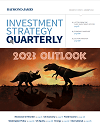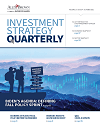“Our hearts aching, our prayers praying, our flags waving, never forget.” These prescient words spoken by the maker of our nation’s flag, Betsy Ross, are just as true today as they were more than 240 years ago. We ache for those who are suffering from COVID-19, economic hardship and social injustice. We pray for those protecting and defending liberty and justice for all. Our flag is still waving knowing our country will recover from today’s challenges and grow toward a better America, as 2020 will surely be a year we never forget. We maintain our belief in the ‘American Dream’ as described by James Truslow Adams, that “life should be better and richer and fuller for everyone, with opportunity for each according to ability or achievement,” regardless of social class or circumstances of birth. We not only acknowledge but embrace that we have work to do as a society, and hope that this year will serve as an inflection point as we advance toward a stronger and more united country. – Chief Investment Officer Larry Adam, CFA, CIMA®, CFP®
Whether it be wars, pandemics, financial crises, or bubbles bursting, the U.S. economy has a history of resiliency, and even in the aftermath of the COVID-19 outbreak, it will be gleaming once again. The scale of the global lockdown likely caused the most significant global recession in the post-World War II era. However, it will likely be the shortest recession on record, as the dawn’s early light of a recovery is signaling a robust rebound in the second half of 2020. Leading indicators and real-time activity metrics suggest the bottom occurred in April, as states eased restrictions, labor market conditions improved and consumer spending was revitalized. Admittedly, the depth of the decline (possibly 35% quarter-over-quarter decline in annualized gross domestic product [GDP] for the second quarter) means it will take time for the economy to return to pre-COVID-19 GDP levels, which we expect will not occur until the end of 2021 at the earliest. As a result, our forecast is that U.S. GDP for 2020 will fall by 5.3% before accelerating to 4.9% growth in 2021.
Until the recovery is evident from sea to shining sea, Congress and the Federal Reserve (Fed) will make sparks fly through fiscal and monetary stimulus efforts. The Fed took unprecedented steps to alleviate investor fears, improve credit market functionality, and provide liquidity in order to mitigate the downside risk to the economy. Fortunately, the Fed has not utilized the newly established programs to their full capacity just yet, so plenty of firepower remains. Similarly, Congress swiftly passed record-breaking levels of direct relief and more could be provided soon, as ongoing negotiations have hinted at additional stimulus in support of the recovery rather than just as an emergency response. The cumulative actions built a pillar of support for the U.S. economy and helped avoid the doomsday scenario.
When fear dominated the financial markets, U.S. Treasuries quickly earned their stripes as heightened demand pushed the entire yield curve below 1% for the first time. The realization of an economic rebound should push yields modestly higher (year-end 10-year Treasury target 1.0%), but the upside will be limited. Despite record issuance by the Treasury in support of the economy, interest from the Fed, foreign buyers, retirees, and institutions should keep demand steady. The Fed expanded the scope of its purchase programs to include investment-grade and municipal bonds, so its ongoing purchases should lead spreads to narrow further. Therefore, we favor these sectors over high-yield bonds (of which the Fed is only buying a small portion) which are subject to heightened risk due to the expected uptick in defaults. If investing in the high-yield sector, selectivity will be critical given the high exposure to energy companies and brick-and-mortar retailers, which have arguably suffered the most due to the outbreak.
We pledge our allegiance to U.S. equities, which have benefitted from aggressive policymaker action, states reopening their economies, and promising vaccine clinical trials. Despite the recent rally, we remain confident equities will move higher over the next 12 months, surpassing our year-end S&P 500 target of 3,111, as post-recessionary periods have historically been supportive of the equity market. Our bias toward U.S. equities over international equities isn’t based on patriotism. Much of Europe participated in coordinated fiscal stimulus action, but U.S. economic growth will be more resilient and the rebound should be much more robust. In addition, the sector composition of the S&P 500 is more apt to weather a potential second wave in COVID-19 cases while simultaneously being better positioned to thrive should the economy accelerate as expected. We still favor more cyclical or growth-oriented sectors such as Technology, Communication Services, and Health Care. For long-term investors wanting international exposure, we would consider select Asian emerging market equities as they may benefit from our expectations of a global recovery, a modestly weakening U.S. dollar, and attractive valuations.
Oil prices remain at the liberty of global demand, which will normalize as economies across the globe reopen. The demand fallout from COVID-19 peaked at ~20+ million barrels per day (bpd) earlier this year, but should ease to 5 and 1.25 million bpd in 2021 and 2022, respectively. Prices will also benefit from production cut agreements between OPEC and Russia as they attempt to reduce global oil supply by ~10%, and from the decline in U.S. production due to a reduction in capital expenditures and new wells. With both the demand and supply side of the equation improving, oil prices should end the year around $38 per barrel.
The panic-driven market movements caused by COVID-19 have been subdued, but pullbacks remain possible and should be viewed as a natural, healthy occurrence. We are monitoring the potential risks o’er the ramparts, especially since equity valuations are the highest since 2001 and due to the tremendous amount of optimism priced into the market. The upcoming election is poised to be a perilous fight as the virus-induced recession has altered President Trump’s reelection prospects. No president has won reelection when a recession coincided with the election year, and with the possibility of a Democratic sweep on the rise, the market’s concern for a rollback of the corporate tax cuts may become elevated. In addition, escalating tensions between the U.S. and China have renewed fears surrounding a derailment of the trade truce, and any potential setback in the development of a vaccine could curtail investor confidence as we seek to emerge from this ongoing health crisis.
The original Star-Spangled Banner is on display at the Smithsonian’s National Museum of American History in our nation’s capital as it encompasses the values on which our country was founded: freedom, justice, and equality. Throughout history these values have been tested, and they have always endured. From an investment strategy perspective, this is not the first year investors have faced challenges and it will surely not be the last. However, it is times such as these that prove the principles of asset allocation and selectivity are indeed a perfect union that can help your portfolio stand the test of time. The stars of the flag are located in the ‘northwest quadrant’ when properly flown or hung, and portfolios should strive to move toward this quadrant, too – a place that maximizes return for a given amount of risk.
Read the full July 2020
Investment Strategy Quarterly
Read the full July 2020
Investment Strategy Quarterly
All expressions of opinion reflect the judgment of Raymond James and are subject to change. Investing involves risk including the possible loss of principal. Past performance may not be indicative of future results.
Markets & Investing Members of the Raymond James Investment Strategy Committee share their views on...
Markets & Investing Review the latest Weekly Headings by CIO Larry Adam. Key Takeaways ...
Technology & Innovation Learn about a few simple things you can do to protect your personal information...

